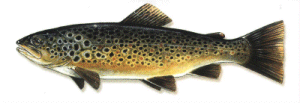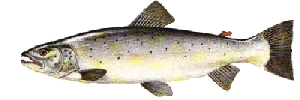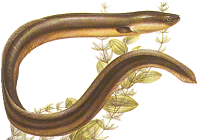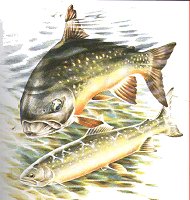The Fish of Loch Ness
Important Information Please Read First
All sighting and photographic references on this page are documented and can be verified through various publications.

Salmon (Salmo salar)
Thousands of miles and up to four years may separate a salmon from its river of birth, but when time for spawning comes the fish will find its way from the Atlantic to the waters where it hatched. The Earth's magnetic field or even the stars may control the salmon's direction-finding in the ocean. At the coast, a chemical memory enables the fish to "smell" its own river. A salmon arriving in fresh water at the end of winter is silver and sleekly plump from its diet of small fish, sand eels and crustaceans. It does not eat again until the autumn spawning is finished, but it will snap at items in the river or loch - including anglers bait. The journey to the headwaters is strenuous, often through wild water and up waterfalls. Large salmon can leap heights of up to 10ft (3m), jumping best from deep water. A salmon can lose almost half its weight from these exertions.
Salmon enter Loch ness and wait until its river has enough water to carry it back to the pool it was born in and there it spawns.
Making the return journey to the sea after spawning results in the death of many of the fish.
Salmon enter Loch ness and wait until its river has enough water to carry it back to the pool it was born in and there it spawns.
Making the return journey to the sea after spawning results in the death of many of the fish.

Trout (Salmo trutta)
Wide variations in colour and growth rate, depending on the local environment, have resulted in many forms of the trout - for example, the silvery seatrout, the dark spotted Loch Leven trout, Orkney trout and Irish trout. However, they are all one species which has a migratory habit over part of its range.
The large eggs of the trout contain copious reserves of yolk. They may take over six weeks to hatch into alevins, or sac-fry (so called because the yolk sac remains attached). For two or three weeks - or longer if the water is cold - the alevins obtain nourishment from the yolk. Gradually they start searching for food. Growth rate depends on food availability.
The large eggs of the trout contain copious reserves of yolk. They may take over six weeks to hatch into alevins, or sac-fry (so called because the yolk sac remains attached). For two or three weeks - or longer if the water is cold - the alevins obtain nourishment from the yolk. Gradually they start searching for food. Growth rate depends on food availability.

Sea Trout
Sea Trout feed on small fish such as sprats. They grow much faster than river and loch dwelling trout, whose diet is chiefly invertebrates such as insect larvae - though some freshwater trout turn to feeding on small fish and grow much faster.
After two or three years, both sea and freshwater trout move upriver to spawn. Trout live for about five or six years, but 20 year specimens have been caught.
After two or three years, both sea and freshwater trout move upriver to spawn. Trout live for about five or six years, but 20 year specimens have been caught.

Eel (Anguilla anguilla)
The eel has been fished, farmed and eaten in Europe for centuries - yet scientifically there is still much that is mysterious about its life. For example, the yellow eel is found as two distinct types, by far the most common with a broad, blunt head, the other with a slim, sharp snout. Why two types exist and how they are related is not known.
In fresh water their food includes snails, frogs, tadpoles and fish eggs. The freshwater stage of their lives may last up to 30 years.
In fresh water their food includes snails, frogs, tadpoles and fish eggs. The freshwater stage of their lives may last up to 30 years.

Charr (Salvelinus alpinus)
Charr closely resemble their relatives the trout and salmon, but occur less widely. Several lakes in England have charr populations. The fish are also found in a number of Scottish lochs including Loch Ness, Irish loughs and in Llyn Peris and Llyn Padarn in Wales. Most populations show minor differences in size and colouting, and in some cases they have been given different names. The Welsh charr is called torgoch (red belly).
In different lakes and lochs spawning habits, feeding and growth rates differ. In Britain there appear to be two groups; those that spawn in deep water in late winter or spring and those that spawn in shallow water in autumn. Both groups may occur in one lake. Yellow eggs measuring 3mm are shed on gravel in still or flowing waters.
In different lakes and lochs spawning habits, feeding and growth rates differ. In Britain there appear to be two groups; those that spawn in deep water in late winter or spring and those that spawn in shallow water in autumn. Both groups may occur in one lake. Yellow eggs measuring 3mm are shed on gravel in still or flowing waters.

Sturgeon (Acipenser sturio)
Sturgeon, any of the numerous fishes of the family Acipenseridae, native to temperate waters of the Northern Hemisphere. Related to the paddlefish and perhaps to the bichir,sturgeons have five longitudinal rows of bony plates(scutes) on the body,an unequally lobed tail fin, and a long snout with a toothless mouth and four sensitive barbels on the underside of the snout. The barbels are dragged over the bottom in search of invertebrates, small fishes, and other food.
Sturgeons may attain great size and age (possibly 200-300 years in the beluga). Members of most species live in the sea and ascend rivers (possibly once in several years) to spawn in spring or summer. The eggs are small, sticky and numerous. The young grow rapidly until maturity,after which growth continues slowly for several years. Sturgeons are valued for their flesh, roe (or caviar); they are readily overfished, however,and fishing in some areas is strictly limited.
The common Old World sturgeon occurs from Scandanavia to the Mediterranean.
Sturgeons may attain great size and age (possibly 200-300 years in the beluga). Members of most species live in the sea and ascend rivers (possibly once in several years) to spawn in spring or summer. The eggs are small, sticky and numerous. The young grow rapidly until maturity,after which growth continues slowly for several years. Sturgeons are valued for their flesh, roe (or caviar); they are readily overfished, however,and fishing in some areas is strictly limited.
The common Old World sturgeon occurs from Scandanavia to the Mediterranean.


No comments:
Post a Comment